外研版(2019)必修第三册Unit 5 understanding ideas reading skills 课件(共31张PPT)
文档属性
| 名称 | 外研版(2019)必修第三册Unit 5 understanding ideas reading skills 课件(共31张PPT) | 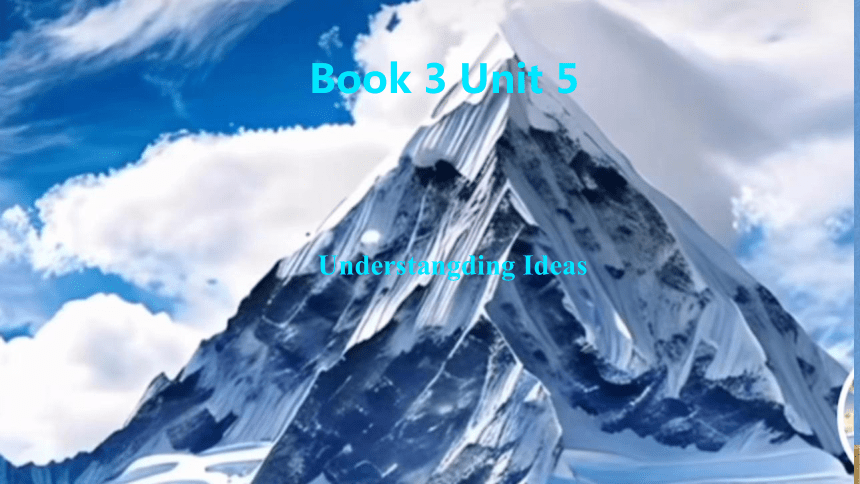 | |
| 格式 | pptx | ||
| 文件大小 | 23.6MB | ||
| 资源类型 | 教案 | ||
| 版本资源 | 外研版(2019) | ||
| 科目 | 英语 | ||
| 更新时间 | 2025-06-24 12:47:28 | ||
图片预览

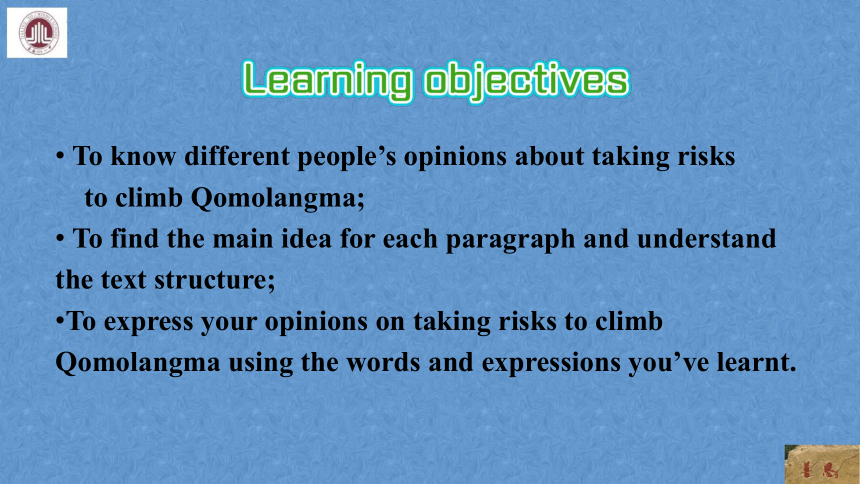
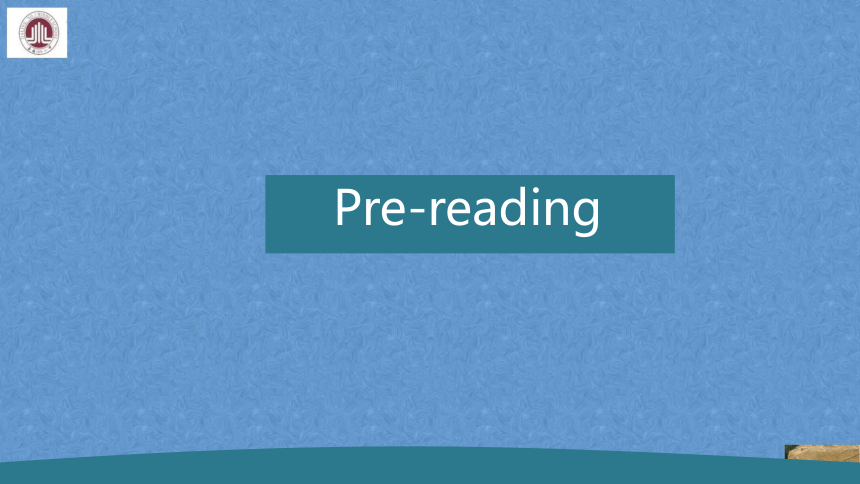
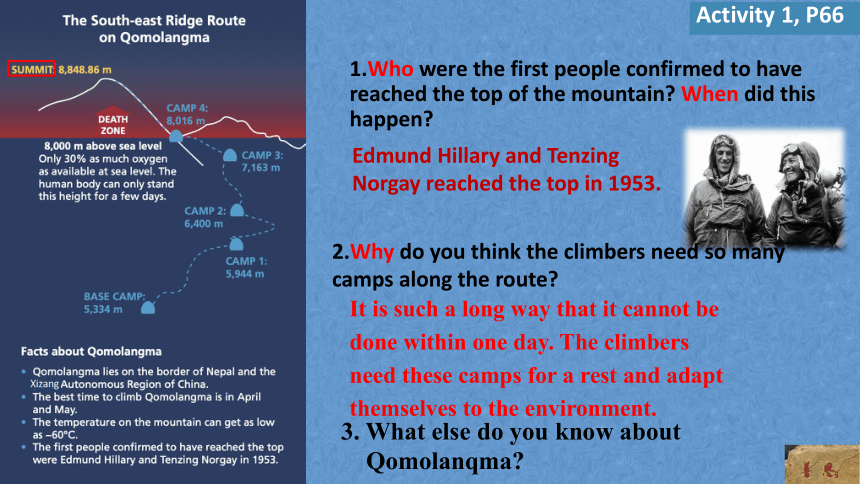
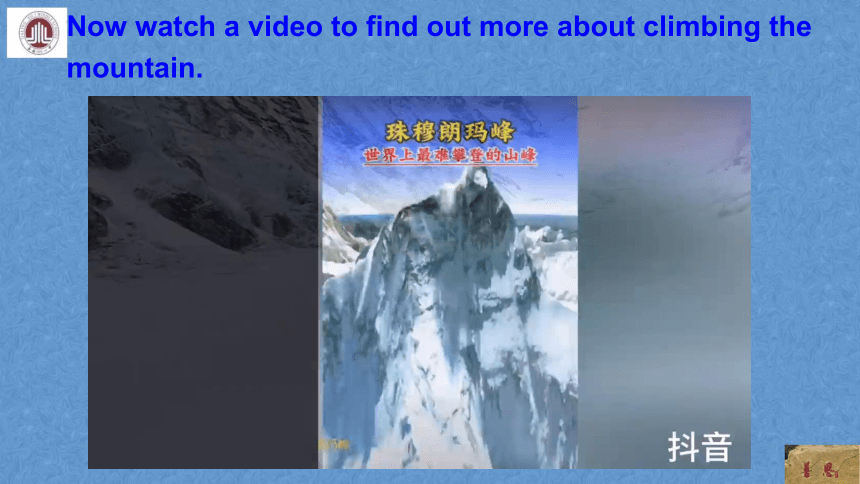
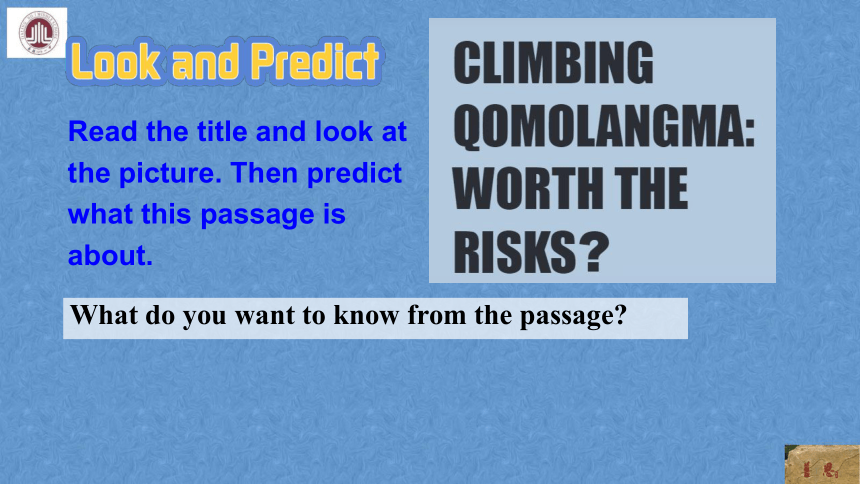
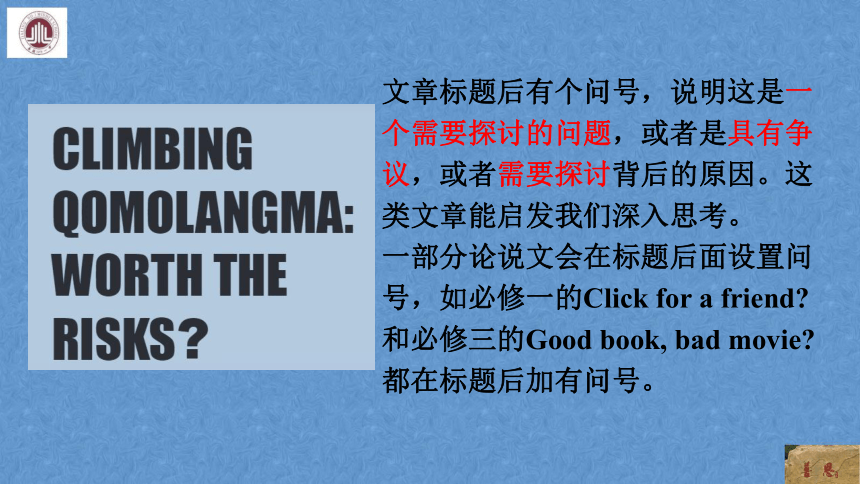
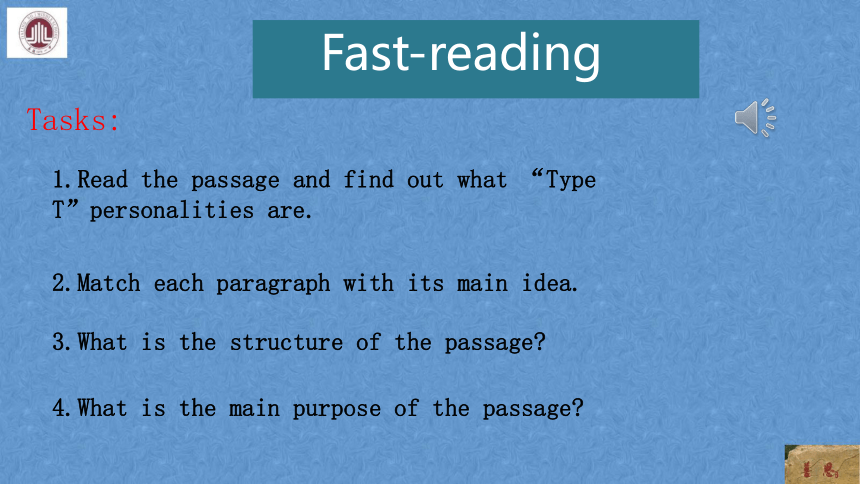
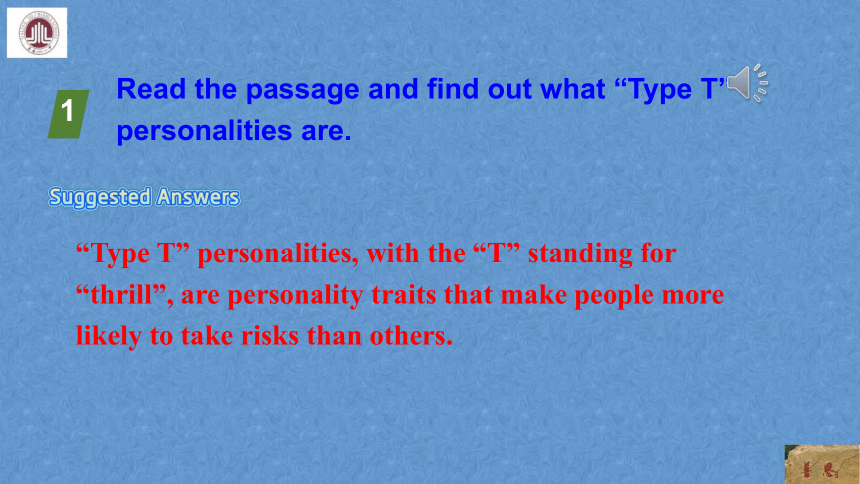
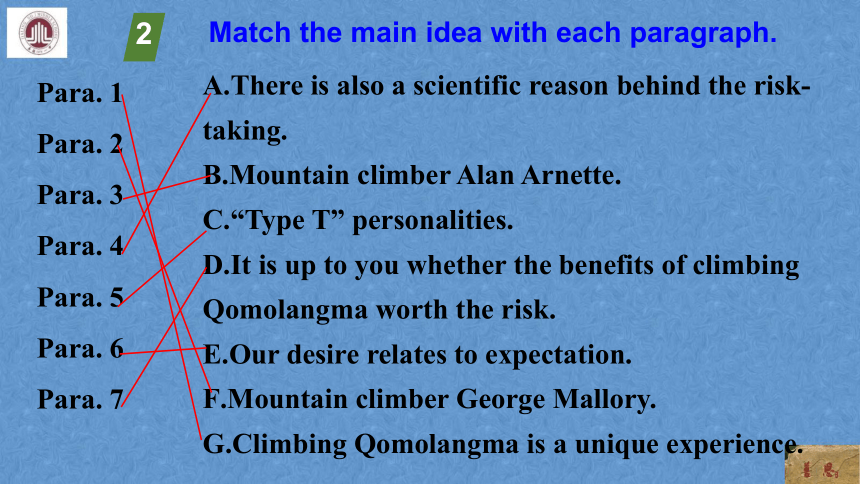
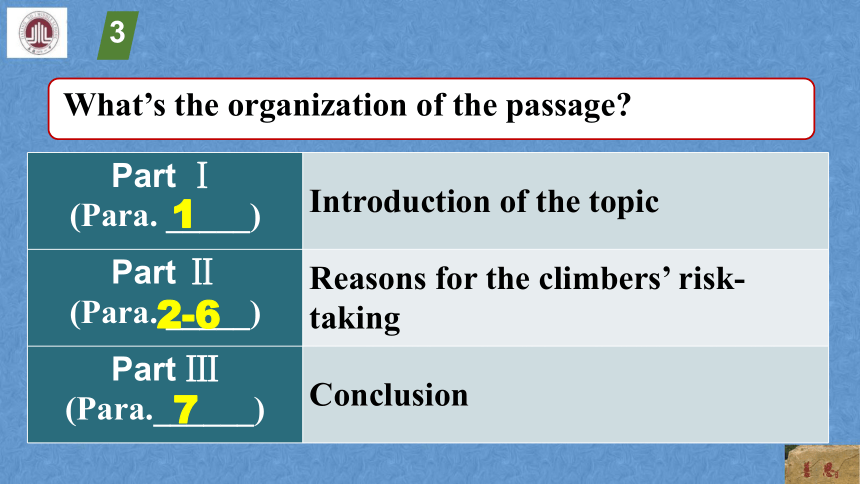
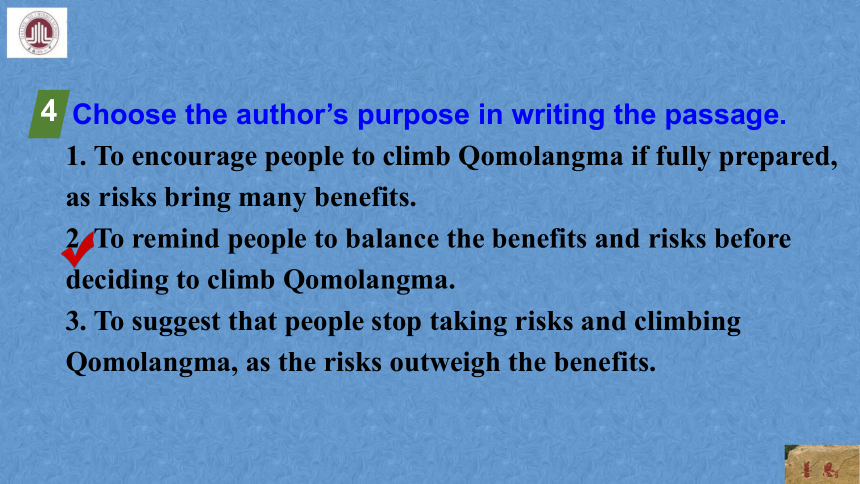
文档简介
(共31张PPT)
Book 3 Unit 5
Understangding Ideas
To know different people’s opinions about taking risks
to climb Qomolangma;
To find the main idea for each paragraph and understand the text structure;
To express your opinions on taking risks to climb Qomolangma using the words and expressions you’ve learnt.
Pre-reading
1.Who were the first people confirmed to have reached the top of the mountain When did this happen
2.Why do you think the climbers need so many camps along the route
Activity 1, P66
Edmund Hillary and Tenzing Norgay reached the top in 1953.
3. What else do you know about
Qomolanqma
It is such a long way that it cannot be done within one day. The climbers need these camps for a rest and adapt themselves to the environment.
Now watch a video to find out more about climbing the mountain.
Read the title and look at the picture. Then predict what this passage is about.
What do you want to know from the passage
文章标题后有个问号,说明这是一个需要探讨的问题,或者是具有争议,或者需要探讨背后的原因。这类文章能启发我们深入思考。
一部分论说文会在标题后面设置问号,如必修一的Click for a friend 和必修三的Good book, bad movie 都在标题后加有问号。
Tasks:
2.Match each paragraph with its main idea.
3.What is the structure of the passage
Fast-reading
4.What is the main purpose of the passage
1.Read the passage and find out what “Type T”personalities are.
Read the passage and find out what “Type T” personalities are.
“Type T” personalities, with the “T” standing for “thrill”, are personality traits that make people more likely to take risks than others.
1
Match the main idea with each paragraph.
Para. 1
Para. 2
Para. 3
Para. 4
Para. 5
Para. 6
Para. 7
There is also a scientific reason behind the risk-taking.
Mountain climber Alan Arnette.
“Type T” personalities.
It is up to you whether the benefits of climbing Qomolangma worth the risk.
Our desire relates to expectation.
Mountain climber George Mallory.
Climbing Qomolangma is a unique experience.
2
What’s the organization of the passage
Part Ⅰ (Para. _____) Introduction of the topic
Part Ⅱ (Para. _____) Reasons for the climbers’ risk-taking
Part Ⅲ (Para.______) Conclusion
1
2-6
7
3
Choose the author’s purpose in writing the passage.
1. To encourage people to climb Qomolangma if fully prepared, as risks bring many benefits.
2. To remind people to balance the benefits and risks before deciding to climb Qomolangma.
3. To suggest that people stop taking risks and climbing Qomolangma, as the risks outweigh the benefits.
4
Careful reading
What risks did they have
2.What’s the function of Para.1
crowdscome sick
extreme cold
discomfort
danger
below air pressure
lose their lives
To introduce the topic
Careful reading,and answer the questions.
题目 1:细节理解题(基础)
What did many people who climbed Qomolangma last year plan to do after the trip
A. Give up climbing forever.
B. Plan another climbing trip.
C. Share their stories with others.
D. Donate money to help climbers.
题目 1:细节理解题(进阶)
Why did many climbers plan to return to Qomolangma despite the risks
A. They wanted to prove their physical strength.
B. The challenge and achievement attracted them.
C. They needed to complete unfinished tasks.
D. Their families encouraged them to try again.
B
B
Careful reading,and answer the questions.
题目 2:细节理解题
题干:When did George Mallory die
A. In 1914. B. In 1924.
C. In 2011. D. In 2023.
题目 3:推理判断题(中等)
What can be inferred about George Mallory’s climbing goal
A. His main aim was to become a famous explorer.
B. He climbed to test new climbing technologies.
C. Reaching the summit(顶点) was a significant personal pursuit(追求,爱好).
D. He climbed for scientific research purposes.
B
C
Careful reading,and answer the questions.
Complete the paragraphs with the expressions from the passage.
Why Do People Climb Qomolangma
George Mallory
What people get from this adventure is just __________. People eat and make money to be able to _________, not the other way round.
sheer joy
enjoy life
题目 4:细节理解题
题干:What does Alan Arnette think climbing Qomolangma can do
A. It helps people make more money.
B. It makes people realize what matters most.
C. It forces people to take unnecessary risks.
D. It teaches people to respect nature.
题目 5:词义猜测题
The word “push” in Paragraph 3 probably means ______.
A. move forward
B. push something hard
C. give up easily
D. feel afraid
Careful reading,and answer the questions.
A
B
Alan Arnette
Each person has a (n) __________________ reason for climbing a mountain. It forces people to __________________ themselves. To succeed, people must have the physical as well as __________________.
important and unique
look deep inside
mental toughness
Careful reading,and answer the questions.
题目 6:细节理解题
What do “Type T” people think of their risky behaviors
A. They are just doing their jobs as experts.
B. They are taking great risks on purpose.
C. They will definitely die if they keep doing so.
D. They should stop these dangerous activities.
A
题目 6:推理判断题(中等)
Why do “Type T” people claim they are not taking risks
A. They are unaware of the actual dangers.
B. Their skills and experience make them feel secure.
C. They underestimate the potential risks.
D. They are trying to persuade others to join them.
B
暗示,表明
题目 7:细节理解题
According to Paragraph 6, our desire to seek risks is connected to ______.
A. how much money we have
B. how much we expect to benefit
C. how many friends we have
D. how strong we are physically
B
Careful reading,and answer the questions.
Careful reading,and answer the questions.
human nature
take risks
benefit from the result
题目 8:推理判断题
What is the author’s attitude towards climbing Qomolangma
A. Supportive. B. Opposed.
C. Neutral. D. Critical.
题目 10:推理判断题(较高难度)
题干:What is the author’s purpose in mentioning different perspectives on climbing Qomolangma
A. To persuade readers to try climbing themselves.
B. To highlight the importance of professional training.
C. To show that the decision to climb involves complex factors.
D. To criticize those who engage in extreme sports.
Careful reading,and answer the questions.
题目9:主旨大意题(较高难度)
Which of the following best summarizes the passage
A. Climbing Qomolangma is a foolish and dangerous activity.
B. The history of Qomolangma climbing from Mallory to modern times.
C. People’s motivations for climbing Qomolangma and the nature of risk-taking.
D. How to prepare for a safe climbing experience on Qomolangma.
C
C
C
Careful reading. Underline the key sentences and complete the chart.
Main idea: Scientific reasons behind the risk-taking.
human nature
take risks
benefit from the result
Read the text again and match the people with their ideas.
a. “Type T” personalities don't expect to die.
b. We make money to be able to enjoy life.
c. Climbing brings into focus what's important to you.
d. People who are looking for adventures show a desire for pure joy.
e. The personalities of people who prefer taking risks are “Type T”.
f. People really need physical and mental toughness to keep going on.
George Mallory: _____________________________
Alan Arnette: _____________________________
Frank Farley: _____________________________
b, d
c, f
a, e
Climbing Qomolangma is a tough journey. 1. the extreme cold and danger, many climbers make an 2. to reach the top. After George Mallory’s death in 1924, his body 3. missing for years. People still wonder if he 4. in 5. the summit.
For modern climbers, the 6. and 7. reason to climb is often personal growth. They 8. their minds on the goal, even though taking such a high 9. is dangerous.
Finally, they debate: Is the 10. of climbing worth the pain
Despite
attempt
remained
reaching
significant
unique
focus
risk
benefit
succeeded
Fill in each blank with one proper word 。
Post-reading
批判性思维题(较高难度)
Do you agree that the benefits of climbing Qomolangma are worth the risks Support your answer with evidence from the passage.
解:开放性题目,学生需结合文中 “self-discovery”“thrill”“danger” 等信息,从个人成长、风险代价等角度分析,合理即可。
The best view comes after the hardest climb.
Homework
Summarize we have learnt some key words and expressions today.
Thanks
Book 3 Unit 5
Understangding Ideas
To know different people’s opinions about taking risks
to climb Qomolangma;
To find the main idea for each paragraph and understand the text structure;
To express your opinions on taking risks to climb Qomolangma using the words and expressions you’ve learnt.
Pre-reading
1.Who were the first people confirmed to have reached the top of the mountain When did this happen
2.Why do you think the climbers need so many camps along the route
Activity 1, P66
Edmund Hillary and Tenzing Norgay reached the top in 1953.
3. What else do you know about
Qomolanqma
It is such a long way that it cannot be done within one day. The climbers need these camps for a rest and adapt themselves to the environment.
Now watch a video to find out more about climbing the mountain.
Read the title and look at the picture. Then predict what this passage is about.
What do you want to know from the passage
文章标题后有个问号,说明这是一个需要探讨的问题,或者是具有争议,或者需要探讨背后的原因。这类文章能启发我们深入思考。
一部分论说文会在标题后面设置问号,如必修一的Click for a friend 和必修三的Good book, bad movie 都在标题后加有问号。
Tasks:
2.Match each paragraph with its main idea.
3.What is the structure of the passage
Fast-reading
4.What is the main purpose of the passage
1.Read the passage and find out what “Type T”personalities are.
Read the passage and find out what “Type T” personalities are.
“Type T” personalities, with the “T” standing for “thrill”, are personality traits that make people more likely to take risks than others.
1
Match the main idea with each paragraph.
Para. 1
Para. 2
Para. 3
Para. 4
Para. 5
Para. 6
Para. 7
There is also a scientific reason behind the risk-taking.
Mountain climber Alan Arnette.
“Type T” personalities.
It is up to you whether the benefits of climbing Qomolangma worth the risk.
Our desire relates to expectation.
Mountain climber George Mallory.
Climbing Qomolangma is a unique experience.
2
What’s the organization of the passage
Part Ⅰ (Para. _____) Introduction of the topic
Part Ⅱ (Para. _____) Reasons for the climbers’ risk-taking
Part Ⅲ (Para.______) Conclusion
1
2-6
7
3
Choose the author’s purpose in writing the passage.
1. To encourage people to climb Qomolangma if fully prepared, as risks bring many benefits.
2. To remind people to balance the benefits and risks before deciding to climb Qomolangma.
3. To suggest that people stop taking risks and climbing Qomolangma, as the risks outweigh the benefits.
4
Careful reading
What risks did they have
2.What’s the function of Para.1
crowdscome sick
extreme cold
discomfort
danger
below air pressure
lose their lives
To introduce the topic
Careful reading,and answer the questions.
题目 1:细节理解题(基础)
What did many people who climbed Qomolangma last year plan to do after the trip
A. Give up climbing forever.
B. Plan another climbing trip.
C. Share their stories with others.
D. Donate money to help climbers.
题目 1:细节理解题(进阶)
Why did many climbers plan to return to Qomolangma despite the risks
A. They wanted to prove their physical strength.
B. The challenge and achievement attracted them.
C. They needed to complete unfinished tasks.
D. Their families encouraged them to try again.
B
B
Careful reading,and answer the questions.
题目 2:细节理解题
题干:When did George Mallory die
A. In 1914. B. In 1924.
C. In 2011. D. In 2023.
题目 3:推理判断题(中等)
What can be inferred about George Mallory’s climbing goal
A. His main aim was to become a famous explorer.
B. He climbed to test new climbing technologies.
C. Reaching the summit(顶点) was a significant personal pursuit(追求,爱好).
D. He climbed for scientific research purposes.
B
C
Careful reading,and answer the questions.
Complete the paragraphs with the expressions from the passage.
Why Do People Climb Qomolangma
George Mallory
What people get from this adventure is just __________. People eat and make money to be able to _________, not the other way round.
sheer joy
enjoy life
题目 4:细节理解题
题干:What does Alan Arnette think climbing Qomolangma can do
A. It helps people make more money.
B. It makes people realize what matters most.
C. It forces people to take unnecessary risks.
D. It teaches people to respect nature.
题目 5:词义猜测题
The word “push” in Paragraph 3 probably means ______.
A. move forward
B. push something hard
C. give up easily
D. feel afraid
Careful reading,and answer the questions.
A
B
Alan Arnette
Each person has a (n) __________________ reason for climbing a mountain. It forces people to __________________ themselves. To succeed, people must have the physical as well as __________________.
important and unique
look deep inside
mental toughness
Careful reading,and answer the questions.
题目 6:细节理解题
What do “Type T” people think of their risky behaviors
A. They are just doing their jobs as experts.
B. They are taking great risks on purpose.
C. They will definitely die if they keep doing so.
D. They should stop these dangerous activities.
A
题目 6:推理判断题(中等)
Why do “Type T” people claim they are not taking risks
A. They are unaware of the actual dangers.
B. Their skills and experience make them feel secure.
C. They underestimate the potential risks.
D. They are trying to persuade others to join them.
B
暗示,表明
题目 7:细节理解题
According to Paragraph 6, our desire to seek risks is connected to ______.
A. how much money we have
B. how much we expect to benefit
C. how many friends we have
D. how strong we are physically
B
Careful reading,and answer the questions.
Careful reading,and answer the questions.
human nature
take risks
benefit from the result
题目 8:推理判断题
What is the author’s attitude towards climbing Qomolangma
A. Supportive. B. Opposed.
C. Neutral. D. Critical.
题目 10:推理判断题(较高难度)
题干:What is the author’s purpose in mentioning different perspectives on climbing Qomolangma
A. To persuade readers to try climbing themselves.
B. To highlight the importance of professional training.
C. To show that the decision to climb involves complex factors.
D. To criticize those who engage in extreme sports.
Careful reading,and answer the questions.
题目9:主旨大意题(较高难度)
Which of the following best summarizes the passage
A. Climbing Qomolangma is a foolish and dangerous activity.
B. The history of Qomolangma climbing from Mallory to modern times.
C. People’s motivations for climbing Qomolangma and the nature of risk-taking.
D. How to prepare for a safe climbing experience on Qomolangma.
C
C
C
Careful reading. Underline the key sentences and complete the chart.
Main idea: Scientific reasons behind the risk-taking.
human nature
take risks
benefit from the result
Read the text again and match the people with their ideas.
a. “Type T” personalities don't expect to die.
b. We make money to be able to enjoy life.
c. Climbing brings into focus what's important to you.
d. People who are looking for adventures show a desire for pure joy.
e. The personalities of people who prefer taking risks are “Type T”.
f. People really need physical and mental toughness to keep going on.
George Mallory: _____________________________
Alan Arnette: _____________________________
Frank Farley: _____________________________
b, d
c, f
a, e
Climbing Qomolangma is a tough journey. 1. the extreme cold and danger, many climbers make an 2. to reach the top. After George Mallory’s death in 1924, his body 3. missing for years. People still wonder if he 4. in 5. the summit.
For modern climbers, the 6. and 7. reason to climb is often personal growth. They 8. their minds on the goal, even though taking such a high 9. is dangerous.
Finally, they debate: Is the 10. of climbing worth the pain
Despite
attempt
remained
reaching
significant
unique
focus
risk
benefit
succeeded
Fill in each blank with one proper word 。
Post-reading
批判性思维题(较高难度)
Do you agree that the benefits of climbing Qomolangma are worth the risks Support your answer with evidence from the passage.
解:开放性题目,学生需结合文中 “self-discovery”“thrill”“danger” 等信息,从个人成长、风险代价等角度分析,合理即可。
The best view comes after the hardest climb.
Homework
Summarize we have learnt some key words and expressions today.
Thanks
